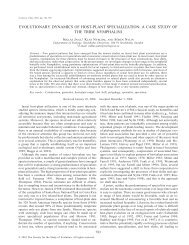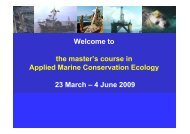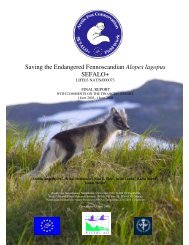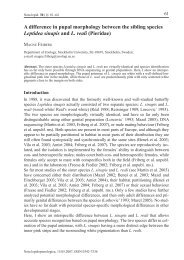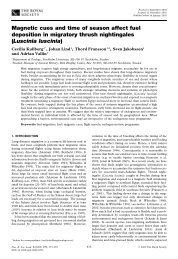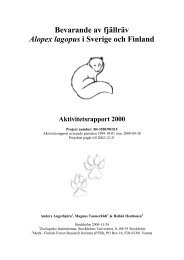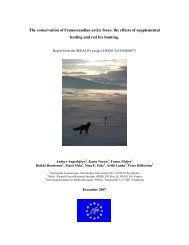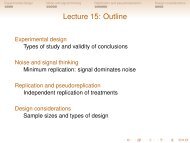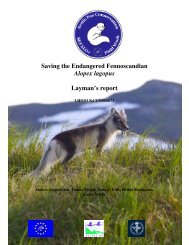Evolution of Fighting Behaviour: The Effect of Variation in Resource ...
Evolution of Fighting Behaviour: The Effect of Variation in Resource ...
Evolution of Fighting Behaviour: The Effect of Variation in Resource ...
Create successful ePaper yourself
Turn your PDF publications into a flip-book with our unique Google optimized e-Paper software.
GAMES WITH VARIATION IN RESOURCE VALUE 201BRUCE, R. H. (1941). An experimental analysis <strong>of</strong> social factors affect<strong>in</strong>g the performance <strong>of</strong> white rats.III. Dom<strong>in</strong>ance and cooperation motivated by water and food deprivation. J. comp. PsychoL 31, 395.CLU'rrON-BROCK, T. H. ALBON, S. D., GIBSON, R. M. & GUINNESS, F. E. (1979). <strong>The</strong> logical stag:adaptive aspects <strong>of</strong> fight<strong>in</strong>g <strong>in</strong> red deer (Cervus elaphus L). Anita. Behav. 27, 211.COLE, D. D. & SHAFFER, J. N. (t966). A study <strong>of</strong> social dom<strong>in</strong>ance <strong>in</strong> cats. <strong>Behaviour</strong> 27, 39.DAWKINS, R. & BROCKMANN, H. J. (1980). DO digger wasps commit the concorde fallacy? Anita.Behav. 28, 892.ENQUIST, M. & LEIMAR, O. (1983). <strong>Evolution</strong> <strong>of</strong> fight<strong>in</strong>g behaviour: decision rules and assessment <strong>of</strong>relative strength. J. theor. Biol. 102, 387.ENQUIST, M., PLANE, E. & ROED, J. (1985). Aggressive communication <strong>in</strong> fulmar Fulmarus gtacialis.Anita Behav. 33, 1007.ESHEL, I. (1983). <strong>Evolution</strong>ary and cont<strong>in</strong>uous stability. J. theor. Biol. 103, 99.HAMMERSTEIN, P. & PARKER, G. A. (1982). <strong>The</strong> asymmetric war <strong>of</strong> attrition. Z theor. Biol. 96, 647.HANSEN, A. J. (1986). <strong>Fight<strong>in</strong>g</strong> behavior <strong>in</strong> bald eagles: a test <strong>of</strong> game theory. Ecology 67, 787.HAZLETq', B. A. (1966). Factors affect<strong>in</strong>g the aggressive behaviour <strong>of</strong> the hermit crab Calc<strong>in</strong>ius tibicen.Z. tierpsychol. 23, 655.HAZLETT, B. A. & ESTABROOK, F. (1974). Exam<strong>in</strong>ation <strong>of</strong> agonistic behaviour by character analysis,1. <strong>The</strong> spider crab Microphrys bicornutus. <strong>Behaviour</strong> 48, 131.HAZLE'VI', B. A., RUBENSTEIN, D. 1. & RITSCHOFF, D. (1975). Starvation, aggression, and energyreserves <strong>in</strong> the crayfish Orconectes oirilis. Crustaceana 8, 11.KIKKAVA, J. (1968). Social hierarchy <strong>in</strong> w<strong>in</strong>ter flocks <strong>of</strong> the grey-breasted silver eye Zosterops lateralis(Latham). Jap. J. Ecol. 18, 235.LEIMAR, O. & ENQUIST, M. (1984). <strong>Effect</strong>s <strong>of</strong> asymmetries <strong>in</strong> owner-<strong>in</strong>truder <strong>in</strong>teractions. J. theor. Biol.i11,475.MAYNARD SM ITH, J. (1982). <strong>Evolution</strong> and the theory <strong>of</strong> games. Cambridge: Cambridge University Press.MAYNARD SMITH, J. & PARKER, G. A. (1976). <strong>The</strong> logic <strong>of</strong> asymmetric contests. Anita. Behav. 24, 154.NOWLIS, V. (1941). <strong>The</strong> relation <strong>of</strong> degree <strong>of</strong> hunger to competitive <strong>in</strong>teraction <strong>in</strong> chimpanzee. J. comp.Psychol. 32, 91.RAND, W. M. t~ RAND, A. S. (1976). Agonistic behaviour <strong>in</strong> nest<strong>in</strong>g iguanas: a stochastic analysis <strong>of</strong>dispute settlement dom<strong>in</strong>ated by the m<strong>in</strong>imization <strong>of</strong> energy cost. Z. tierpsychol. 40, 279.RIECHERT, S. E. (1979). Games spiders play. II. <strong>Resource</strong> assessment strategies. Behav. Ecol. Sociobiol.6, 121.RIECHERT, S. E. (1984). Games spiders play. IIt. Cues underly<strong>in</strong>g context associated changes <strong>in</strong> agonisticbehaviour. Anita. Behav. 32, t.SIGUR.IONSDrTTIR, H. & PARKER, G. A. (1981). Dungfly struggles: evidence for assessment strategy.Behav. Ecol. Sociobiol. 8, 219,VERRELL, P. A. (1986). Wrestl<strong>in</strong>g <strong>in</strong> the red-spotted newt (Notophthahnus viridens): resource value andcontestant asymmetry determ<strong>in</strong>e contest duration and outcome. Anita. Behav. 34, 398.APPENDIXAConsider contests with no role asymmetry and the same resource value for bothcontestants. Let S(v) be a curve through the space <strong>of</strong> strategies, parametrized by v,with the property that S(v) is an ESS when the value, V, <strong>of</strong> the resource is equalto v. Let p(u, w) and C(v, w) be, respectively, the probability <strong>of</strong> w<strong>in</strong>n<strong>in</strong>g and thecost for S(v) <strong>in</strong> a contest aga<strong>in</strong>st S(w). We will show that if S(V) is cont<strong>in</strong>uouslystable then p(v, w) and C(v, w) will <strong>in</strong>crease with v at v = w = V.When the value <strong>of</strong> the resource is equal to V, the utility <strong>of</strong> S(v) aga<strong>in</strong>st S(w) isU(v, w)=p(v, w)V-C(v, w). For S(V) to be an ESS, it is necessary thatoU ap V aC. . . . . . 0 (A1)Ov Ov Ovat v = w = V. Equation (A1) holds identically <strong>in</strong> V(v = w = V) for some <strong>in</strong>terval <strong>of</strong>



